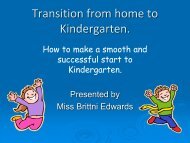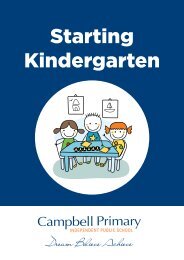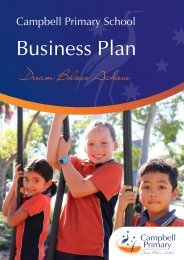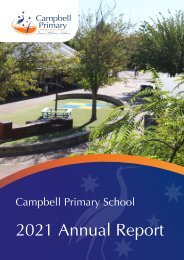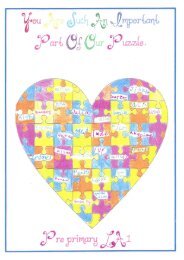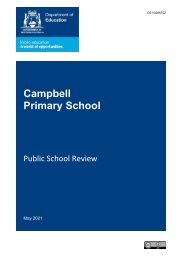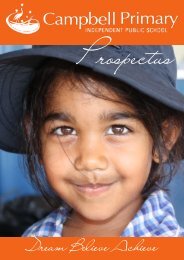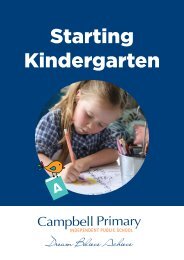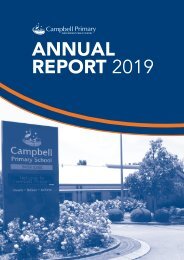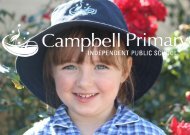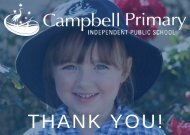Exploring STEM at home
Exploring STEM at home
Exploring STEM at home
You also want an ePaper? Increase the reach of your titles
YUMPU automatically turns print PDFs into web optimized ePapers that Google loves.
Kindergarten to Year 2<br />
EXPLORING<br />
<strong>STEM</strong> AT<br />
HOME<br />
Science, technology, engineering<br />
and m<strong>at</strong>hem<strong>at</strong>ics<br />
Activities and ideas for<br />
parents to support their<br />
children’s learning and<br />
development.<br />
© Department of Educ<strong>at</strong>ion, Western Australia 2017
WHAT’S INSIDE<br />
CHILDREN ARE NATURALLY CURIOUS 1<br />
WHAT IS <strong>STEM</strong>? 2<br />
PLAY IS ESSENTIAL FOR LEARNING 3<br />
TOY BOX FUN 4<br />
IN THE KITCHEN 5<br />
QUESTIONING SKILLS 7<br />
LEARNING THROUGH READING 7<br />
ON RAINY DAYS 8<br />
COLLECTING TREASURES 9<br />
THE GREAT OUTDOORS 10<br />
AT NIGHT 12<br />
AT THE BEACH 13<br />
IN THE PARK 13<br />
BUBBLE BLOWING 14<br />
BATH TIME PLAY 15<br />
RETHINK, REDUCE, RECYCLE AND REUSE 16<br />
TITLE: <strong>Exploring</strong> <strong>STEM</strong> <strong>at</strong> <strong>home</strong>:<br />
Science, technology, engineering and<br />
m<strong>at</strong>hem<strong>at</strong>ics.<br />
SCIS NO: 1831078<br />
ISBN: 978-0-7307-4608-9<br />
© Department of Educ<strong>at</strong>ion, Western<br />
Australia 2017<br />
This public<strong>at</strong>ion may be freely copied<br />
in whole or part and in any form<strong>at</strong> in an<br />
educ<strong>at</strong>ion institution for non-commercial<br />
educ<strong>at</strong>ion purposes.<br />
This m<strong>at</strong>erial is available on request in<br />
appropri<strong>at</strong>e altern<strong>at</strong>ive form<strong>at</strong>s.<br />
Department of Educ<strong>at</strong>ion<br />
151 Royal Street<br />
East Perth WA 6004<br />
T: 9264 4111<br />
W: educ<strong>at</strong>ion.wa.edu.au<br />
© Department of Educ<strong>at</strong>ion, Western Australia 2017
CHILDREN ARE<br />
NATURALLY<br />
CURIOUS<br />
Playing, exploring and asking lots of<br />
questions – th<strong>at</strong>’s how children learn<br />
about themselves, about others and<br />
about the world around them.<br />
This booklet has lots of<br />
activities you can do <strong>at</strong><br />
<strong>home</strong> with your children<br />
to support their learning<br />
and development in <strong>STEM</strong><br />
(science, technology,<br />
engineering and<br />
m<strong>at</strong>hem<strong>at</strong>ics).<br />
© Department of Educ<strong>at</strong>ion, Western Australia 2017<br />
1
WHAT IS <strong>STEM</strong>?<br />
<strong>STEM</strong> is an approach to learning and development<br />
th<strong>at</strong> integr<strong>at</strong>es the areas of science, technology,<br />
engineering and m<strong>at</strong>hem<strong>at</strong>ics.<br />
Through <strong>STEM</strong>, children learn to:<br />
• ask questions<br />
• work together<br />
• think cre<strong>at</strong>ively<br />
• solve problems<br />
• explore<br />
• take calcul<strong>at</strong>ed risks<br />
• test solutions<br />
• discover new ways of doing things.<br />
As your child’s first teacher, you can start building<br />
their <strong>STEM</strong> skills from an early age, cre<strong>at</strong>ing a solid<br />
found<strong>at</strong>ion for future learning. By encouraging<br />
your child to play, explore and investig<strong>at</strong>e, you are<br />
helping them become active participants in their<br />
own learning.<br />
With advances in<br />
technology, around<br />
65 per cent of children<br />
starting primary school<br />
are likely to work in jobs<br />
th<strong>at</strong> don’t yet exist.<br />
2 © Department of Educ<strong>at</strong>ion, Western Australia 2017
PLAY IS ESSENTIAL<br />
FOR LEARNING<br />
Play is a fun and important part of<br />
children’s learning and development.<br />
Through play, children:<br />
• are interested in and connected to<br />
wh<strong>at</strong> they are doing<br />
• learn through copying others<br />
• have the freedom to explore their own<br />
interests and answer questions for<br />
themselves<br />
• learn <strong>at</strong> their own pace<br />
• learn to talk and interact with adults<br />
and other children<br />
• develop their imagin<strong>at</strong>ion<br />
• build resilience.<br />
There are many opportunities <strong>at</strong> <strong>home</strong>,<br />
outside and in the community to learn<br />
about <strong>STEM</strong>. And best of all, they’re free.<br />
Mess is good! It’s<br />
an important part of<br />
playing and learning<br />
– so is cleaning up<br />
afterwards.<br />
Wh<strong>at</strong> can I do?<br />
• Develop and respect your child’s curiosity<br />
and cre<strong>at</strong>ivity.<br />
• Let your child discover and learn <strong>at</strong> their<br />
own pace.<br />
• Accept the answers your child provides –<br />
they make perfect sense to them!<br />
• Ask lots of questions. Questions help<br />
your child understand the task.<br />
Give your children the opportunity<br />
to play by themselves and with others<br />
– this builds their confidence and<br />
adaptability skills.<br />
© Department of Educ<strong>at</strong>ion, Western Australia 2017<br />
3
TOY BOX FUN<br />
• With your child, sort objects in the toy box by size,<br />
shape, colour, texture, weight, m<strong>at</strong>erial and use.<br />
• Take two toys and guess which is heavier. Find out<br />
by holding the toys in each hand. Use scales to<br />
compare the weights.<br />
• See how quickly cars, marbles and balls roll down<br />
different surfaces such as baking trays, big books<br />
and planks of wood. See if changing the surface<br />
changes how fast the object goes.<br />
TASK<br />
Make a balance scale by<br />
tying a plastic bag to each<br />
end of a co<strong>at</strong> hanger. Hang<br />
the co<strong>at</strong> hanger on a broom<br />
handle suspended between<br />
two chairs. Place objects in<br />
each bag. See wh<strong>at</strong> happens<br />
when your child adds heavier<br />
and lighter objects.<br />
4 © Department of Educ<strong>at</strong>ion, Western Australia 2017
IN THE KITCHEN<br />
• Show your child th<strong>at</strong> cooking involves<br />
different steps like reading the recipe,<br />
measuring the ingredients and then cooking<br />
in the oven or on the stove.<br />
• Describe to your child wh<strong>at</strong> you are doing<br />
when cooking. Use words such as more,<br />
less, lighter, heavier, melt, cool, hot, cold,<br />
dissolve and set.<br />
• Name and describe ingredients. Get your<br />
child to guess wh<strong>at</strong> will happen when you<br />
mix them together.<br />
• Smell and taste the ingredients (only let your<br />
child taste ingredients you know are safe).<br />
• Talk about how the ingredients change when<br />
you cook them.<br />
Jelly<br />
• Get your child to describe the jelly crystals<br />
before and after w<strong>at</strong>er has been added<br />
(from a solid to a liquid).<br />
• Have your child look in the fridge every half<br />
an hour as the jelly sets and talk about how<br />
it changes.<br />
• Ask wh<strong>at</strong> would happen if some jelly is left<br />
out of the fridge after setting. Try it!<br />
© Department of Educ<strong>at</strong>ion, Western Australia 2017<br />
5
IN THE KITCHEN (CONTINUED)<br />
Play dough<br />
• See how many shapes and p<strong>at</strong>terns you<br />
can make together.<br />
• Add essential oils, glitter and sand to play<br />
dough to change the texture and smell.<br />
Kitchen utensils<br />
• Explore how different kitchen utensils work, like<br />
a can opener and an ice cream scoop.<br />
• Look <strong>at</strong> the reflection on both sides of a spoon.<br />
Ask Why is each side different? and Which side is like<br />
looking in a mirror?<br />
• Get your child to pick up small, big, light and<br />
heavy items with tongs.<br />
TASK<br />
Make a stove with your<br />
child. Talk about the parts<br />
you need, for example an<br />
oven, knobs, switches and<br />
grill. Collect items to cre<strong>at</strong>e<br />
the parts such as boxes,<br />
bottle tops and corrug<strong>at</strong>ed<br />
cardboard. When making<br />
the stove, talk about where<br />
the different parts go and<br />
how they can be <strong>at</strong>tached.<br />
And then paint the stove!<br />
6 © Department of Educ<strong>at</strong>ion, Western Australia 2017
QUESTIONING SKILLS<br />
Questioning encourages children to expand their thoughts r<strong>at</strong>her<br />
than giving yes or no answers.<br />
Ask<br />
Wh<strong>at</strong> does it…<br />
Wh<strong>at</strong> do you think<br />
would happen if…<br />
Why do you think…<br />
How does…<br />
Wh<strong>at</strong> if we…<br />
How can you…<br />
For example<br />
feel like? Close your eyes and<br />
tell me how it feels.<br />
look like? Compare the colour,<br />
p<strong>at</strong>tern, size, shape and texture.<br />
taste like? Have you tasted<br />
something like this before?<br />
smell like? Does it remind you of<br />
something else?<br />
sound like? Where have you<br />
heard this sound before?<br />
we add w<strong>at</strong>er to this?<br />
a playground slide grew bigger?<br />
the shadow has moved?<br />
a robot work?<br />
change the size of the wheels on<br />
different toys?<br />
make blocks balance?<br />
LEARNING THROUGH<br />
READING<br />
With your child, read<br />
The Enormous Turnip<br />
by Irene Y<strong>at</strong>es.<br />
• Talk with your child about the story<br />
using ‘describing’ sentences to give<br />
more inform<strong>at</strong>ion, for example The<br />
turnip is heavy because it is so big.<br />
• Talk about other ways to remove the<br />
turnip, like cutting it into smaller<br />
pieces.<br />
• Talk about different ways to move<br />
objects around the house.<br />
With your child, read<br />
The Very Hungry C<strong>at</strong>erpillar<br />
by Eric Carle.<br />
• With your child, find butterflies in<br />
the garden. Describe the colours<br />
and p<strong>at</strong>terns on their wings.<br />
• Dress up as c<strong>at</strong>erpillars. Move like<br />
a c<strong>at</strong>erpillar. Ask your child to show<br />
you how they would live in a cocoon<br />
– and how they would get out of the<br />
cocoon.<br />
• Talk about how animals and<br />
humans have lifecycles.<br />
© Department of Educ<strong>at</strong>ion, Western Australia 2017 7
ON RAINY DAYS<br />
• Listen to the rain fall on different<br />
surfaces. Ask your child questions<br />
like Wh<strong>at</strong> does it sound like? and<br />
Wh<strong>at</strong> does it smell like?<br />
• W<strong>at</strong>ch wh<strong>at</strong> pets and other<br />
animals do before, during and<br />
after the rain.<br />
• Look <strong>at</strong> the clouds. Talk about<br />
how clouds form different shapes<br />
and colours.<br />
The gre<strong>at</strong> family meltdown<br />
• Give each family member an ice<br />
cube and ask them to find ways<br />
to stop it melting without using<br />
the fridge or freezer. For example,<br />
get them to put it in a sock, wrap<br />
it in foil or bubble wrap, or bury it<br />
in the dirt. Time how long it takes<br />
the ice cubes to melt. Talk about<br />
why some ice cubes melt faster<br />
than others.<br />
TASK<br />
W<strong>at</strong>ch the rain splash<br />
in puddles. Get your<br />
child to make ripples<br />
with their fingers. Look<br />
<strong>at</strong> your reflections.<br />
Splash w<strong>at</strong>er out of the<br />
puddle by jumping in it.<br />
8 © Department of Educ<strong>at</strong>ion, Western Australia 2017
COLLECTING TREASURES<br />
• Collect treasures with your child like shells, small<br />
stones, leaves and fe<strong>at</strong>hers. Display them around your<br />
<strong>home</strong> or keep them in a special place.<br />
• Sort the treasures into groups, for example by colour,<br />
size, texture, shape and the number of edges. Talk<br />
with your child about how each group is similar and<br />
different. Use words like line, circle, square, triangle<br />
and rectangle. Look for repe<strong>at</strong>ed p<strong>at</strong>terns and special<br />
designs.<br />
• Examine each object under<br />
a magnifying glass or take<br />
photos with your phone<br />
and enlarge them on<br />
the screen.<br />
Take lots of photos while<br />
doing activities. Use a<br />
mobile app to change<br />
the way the photos<br />
look. This develops<br />
your child’s digital skills.<br />
© Department of Educ<strong>at</strong>ion, Western Australia 2017<br />
9
THE GREAT OUTDOORS<br />
• Have your child use old kitchen utensils such as<br />
sieves, funnels, dishes and jugs to dig and play with<br />
w<strong>at</strong>er, sand and mud.<br />
• Talk about where w<strong>at</strong>er comes from and where it goes.<br />
Test these ideas by getting your child to paint or spray<br />
w<strong>at</strong>er on a concrete surface and see wh<strong>at</strong> happens.<br />
Extend this activity by discussing how clothes dry after<br />
washing.<br />
• Place torn newspaper into a large jar and soak with<br />
w<strong>at</strong>er. Push some bean seeds half way down the inside<br />
of the jar so they can be seen easily. Put the jar in a<br />
warm, light place and keep the paper moist. W<strong>at</strong>ch<br />
wh<strong>at</strong> happens over a week (the roots grow down from<br />
the seed and the shoots grow up from the seed).<br />
Garden play<br />
• Plant vegetable offcuts and seeds,<br />
flower seeds and seedlings with your<br />
child. W<strong>at</strong>ch how they grow over time.<br />
Take photos to record the changes.<br />
Talk about the changes together.<br />
• Plant them in some different<br />
places to see how they grow<br />
differently (shade or sun, soil<br />
types, pot or garden bed).<br />
Discuss the differences and<br />
wh<strong>at</strong> works best.<br />
TASK<br />
Investig<strong>at</strong>e a small area<br />
of ground with your child<br />
using a magnifying glass.<br />
Ask questions like How<br />
many insects can you see?<br />
Concentr<strong>at</strong>e on one insect<br />
and see wh<strong>at</strong> it is doing.<br />
Follow it to see where it<br />
goes.<br />
10 © Department of Educ<strong>at</strong>ion, Western Australia 2017
© Department of Educ<strong>at</strong>ion, Western Australia 2017<br />
11
AT NIGHT<br />
• Explore outside <strong>at</strong> night with<br />
your child – with and without a<br />
torch. Ask questions like Wh<strong>at</strong><br />
can you see? and Wh<strong>at</strong> can<br />
you hear?<br />
• Make shadows on the wall<br />
with a torch. Talk about how<br />
shadows change when the<br />
torch or objects are moved<br />
closer to or further away from<br />
the wall.<br />
12 © Department of Educ<strong>at</strong>ion, Western Australia 2017
AT THE BEACH<br />
• Get your child to use their senses to explore – like<br />
smelling the air, looking <strong>at</strong> the waves, listening to the<br />
birds, tasting the seaw<strong>at</strong>er and feeling the sand.<br />
• Stand <strong>at</strong> the w<strong>at</strong>er’s edge and let the waves lap up<br />
against your feet. Ask questions like Wh<strong>at</strong> can you feel<br />
under your feet?<br />
TASK<br />
Dig a hole near the w<strong>at</strong>er’s<br />
edge and see how long<br />
it takes to fill with w<strong>at</strong>er.<br />
Talk about where the w<strong>at</strong>er<br />
comes from. Stand in the<br />
hole to see wh<strong>at</strong> happens.<br />
IN THE PARK<br />
• Investig<strong>at</strong>e a tree together. Try and hold hands around<br />
the tree trunk. Ask questions about wh<strong>at</strong> the bark<br />
looks, feels and smells like. See how many colours you<br />
can find. Talk about wh<strong>at</strong> lives in the tree and see if<br />
you can find anything.<br />
• Close your eyes and listen for different sounds. Talk<br />
about wh<strong>at</strong> you can hear, for example the birds and<br />
the wind rustling the leaves. Listen for sounds outside<br />
the park, for example cars and planes.<br />
• Stand still in one place. Talk and ask questions about<br />
the things you can see moving around you like birds<br />
flying overhead, leaves blowing on the ground, dogs<br />
running and people walking.<br />
Playground equipment<br />
• Get swinging! Talk about wh<strong>at</strong> makes the swing work.<br />
Describe how to make the swing go higher.<br />
• Slide down the slide and talk about how and why you<br />
can stop mid-slide.<br />
• Roll an object down the slide. Talk about how to make<br />
it go faster or slower.<br />
© Department of Educ<strong>at</strong>ion, Western Australia 2017<br />
13
BUBBLE BLOWING<br />
• Blow bubbles and get your child to try and c<strong>at</strong>ch them.<br />
Ask questions like Wh<strong>at</strong> makes the bubbles flo<strong>at</strong>? and<br />
Wh<strong>at</strong> makes the bubbles pop? See how long a bubble<br />
can stay in the air.<br />
• Get your child to make bubbles with their hands by<br />
forming a small circle with their thumb and forefinger<br />
and blowing through the circle.<br />
TASK<br />
How to make bubbles<br />
Put 600ml of dishwashing<br />
detergent and 25ml of glycerin<br />
into a one litre container and<br />
fill it with w<strong>at</strong>er. Get your child<br />
to use a pipe cleaner to make<br />
a wand with a circle <strong>at</strong> the top.<br />
Get your child to dip the wand<br />
in the bubble mixture and blow<br />
through the circle.<br />
14 © Department of Educ<strong>at</strong>ion, Western Australia 2017
BATH TIME PLAY<br />
• Put different objects in the b<strong>at</strong>h with your child.<br />
Get your child to see if they flo<strong>at</strong> or sink. Ask them to<br />
guess wh<strong>at</strong> they think might happen before they try.<br />
Ask why some objects flo<strong>at</strong> and others sink. Talk about<br />
ways to make flo<strong>at</strong>ing objects sink, and sinking<br />
objects flo<strong>at</strong>.<br />
• Get your child to fill different objects with w<strong>at</strong>er and<br />
then empty them. Use cleaned shampoo bottles to<br />
squirt w<strong>at</strong>er. Squeeze the bottle when it is empty<br />
and full and talk about how th<strong>at</strong> feels. Squeeze<br />
the bottle under w<strong>at</strong>er and above w<strong>at</strong>er to see wh<strong>at</strong><br />
happens.<br />
Ask questions about wh<strong>at</strong><br />
happens when the b<strong>at</strong>h<br />
plug is removed.<br />
© Department of Educ<strong>at</strong>ion, Western Australia 2017<br />
15
RETHINK, REDUCE, RECYCLE<br />
AND REUSE<br />
Rethink<br />
• R<strong>at</strong>her than driving your child to school, walk there.<br />
If you live far from school, drive part of the way and<br />
walk the rest.<br />
• Encourage your child to think about the way they use<br />
their environment with others. Suggest things like<br />
placing rubbish into bins and tidying up after playing.<br />
Reduce<br />
• Reduce electricity by getting your child to turn off<br />
appliances and lights <strong>at</strong> the wall when they are not<br />
being used. Make signs together as a reminder.<br />
• Get your child to turn off the w<strong>at</strong>er while cleaning<br />
their teeth.<br />
• Show your child the gas, w<strong>at</strong>er and electricity meters<br />
so they understand how utilities are measured.<br />
• Put a bucket in the shower when your child showers<br />
and measure how much w<strong>at</strong>er is collected.<br />
Recycle<br />
• Show your child the ‘recycle’ symbol. Talk about how<br />
important it is to recycle.<br />
• Discuss the sorts of m<strong>at</strong>erials th<strong>at</strong> can and can’t be<br />
recycled.<br />
Reuse<br />
• Reuse paper pl<strong>at</strong>es, boxes, cards, wrapping paper<br />
and ribbon for arts and craft activities. Store buttons,<br />
crayons and pencils in glass or plastic containers.<br />
• Reuse shoeboxes to cre<strong>at</strong>e houses for toys and<br />
treasure boxes.<br />
• Identify ways w<strong>at</strong>er can be collected and reused<br />
around the house, instead of going down the drain.<br />
16 © Department of Educ<strong>at</strong>ion, Western Australia 2017
TASK<br />
Before you throw items<br />
in the rubbish, talk about<br />
wh<strong>at</strong> each item is made of<br />
and ask your child to look<br />
for the recycle symbol.<br />
Sort out the recycling<br />
items together and put<br />
them in the recycle bin.<br />
© Department of Educ<strong>at</strong>ion, Western Australia 2017<br />
17
© Department of Educ<strong>at</strong>ion, Western Australia 2017




